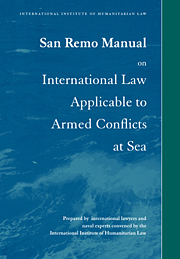 San Remo Manual on International Law Applicable to Armed Conflicts at Sea
San Remo Manual on International Law Applicable to Armed Conflicts at Sea Book contents
- Frontmatter
- Contents
- FOREWORD
- SAN REMO MANUAL
- Introductory note
- Part I General provisions
- Part II Regions of operations
- Part III Basic rules and target discrimination
- Part IV Methods and means of warfare at sea
- Part V Measures short of attack: interception, visit, search, diversion and capture
- Part VI Protected persons, medical transports and medical aircraft
- Annex: Series of meetings and contributions to the project
- EXPLANATION
- INDEX
Part IV - Methods and means of warfare at sea
Published online by Cambridge University Press: 04 August 2010
- Frontmatter
- Contents
- FOREWORD
- SAN REMO MANUAL
- Introductory note
- Part I General provisions
- Part II Regions of operations
- Part III Basic rules and target discrimination
- Part IV Methods and means of warfare at sea
- Part V Measures short of attack: interception, visit, search, diversion and capture
- Part VI Protected persons, medical transports and medical aircraft
- Annex: Series of meetings and contributions to the project
- EXPLANATION
- INDEX
Summary
Section I Means of warfare
Missiles and other projectiles
78 Missiles and projectiles, including those with over-the-horizon capabilities, shall be used in conformity with the principles of target discrimination as set out in paragraphs 38–46.
Torpedoes
79 It is prohibited to use torpedoes which do not sink or otherwise become harmless when they have completed their run.
Mines
80 Mines may only be used for legitimate military purposes including the denial of sea areas to the enemy.
81 Without prejudice to the rules set out in paragraph 82, the parties to the conflict shall not lay mines unless effective neutralisation occurs when they have become detached or control over them is otherwise lost.
82 It is forbidden to use free-floating mines unless:
(a) they are directed against a miliary objective; and
(b) they become harmless within an hour after loss of control over them.
83 The laying of armed mines or the arming of pre-laid mines must be notified unless the mines can only detonate against vessels which are military objectives.
84 Belligerents shall record the locations where they have laid mines.
85 Mining operations in the internal waters, territorial sea or archipelagic waters of a belligerent State should provide, when the mining is first executed, for free exit of shipping of neutral States.
86 Mining of neutral waters by a belligerent is prohibited.
87 Mining shall not have the practical effect of preventing passage between neutral waters and international waters.
- Type
- Chapter
- Information
- San Remo Manual on International Law Applicable to Armed Conflicts at SeaInternational Institute of Humanitarian Law, pp. 25 - 30Publisher: Cambridge University PressPrint publication year: 1995
